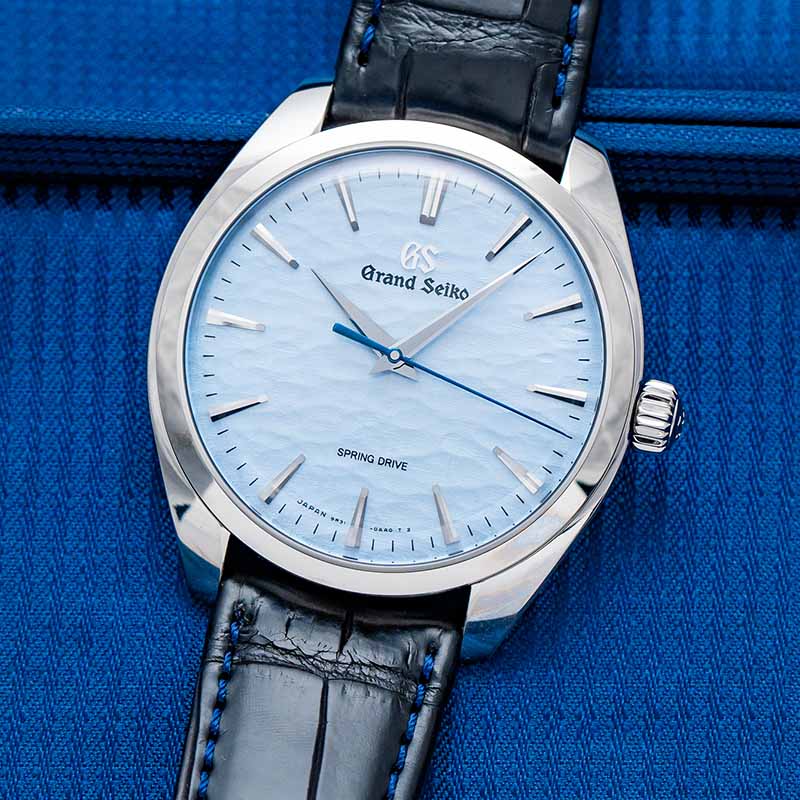As longtime, mutually beneficial relationships in the world of high luxury go, the one between Patek Philippe and Tiffany & Co. is perhaps the most quintessential. The esteemed Swiss watchmaker behind classic timepieces like the Calatrava and Nautilus and the elite retailer/jeweler renowned for its distinctive blue gift boxes have been partners for more than 170 years, and Patek Philippe watches with a Tiffany signature are among the rarest and most coveted items on a serious watch collector’s wishlist. In this feature, I explore the long and prestigious history behind Patek Philippe’s Tiffany watches and spotlight how the two world-famous brands continue to collaborate today.
Patek Philippe: The Origin Story

The company that would be known as Patek Philippe had its foundation laid in 1839, when a Polish watchmaker named Antoni Norbert de Patek and his business partner, Czech-born François Czapek, partnered to form Patek, Czapek, & Cie, in Geneva. The company produced pocket watches for a relatively brief period before disagreements between the two founders precipitated the dissolving of the partnership, and the firm, by 1845. That same year, Patek began a new partnership with a French watchmaker named Adrien Philippe, whose historical claim to fame was the invention of the keyless winding system for watches. Together, they established a new company, Patek & Cie., to continue making watches, which officially became Patek, Philippe, & Cie. in 1851. That year was pivotal for another reason, as it brought about the first meeting between two legendary figures in the history of luxury goods: Antoni Patek and Charles Lewis Tiffany. It proved to be the start of a collaboration that would take both businesses to new heights of success and worldwide prestige.
The Birth of Tiffany & Co.

As if they were predestined for a fruitful, century-spanning partnership, two of the world’s most acclaimed purveyors of luxury items were founded just two years apart. Connecticut-born jeweler and entrepreneur Charles Lewis Tiffany (above) started Tiffany, Young, & Ellis in New York City in 1837 with a partner, John B. Young. Located on Broadway in lower Manhattan, it was initially a “stationery and fancy goods emporium,” which specialized in the former, until Tiffany took full control of the business and shifted its focus to jewelry in 1853, also shortening the name to “Tiffany & Co.” Eventually moving to its current location at 727 Fifth Avenue in midtown, the company has since become a global institution, prized worldwide for its sterling silver and diamond jewelry as well as other luxurious items.

In 1845, Tiffany published its first “Blue Book,” a mail-order catalog that used a very specific shade of robin’s egg blue for the cover. This now-iconic “Tiffany Blue” shade — which is denoted by the Pantone number 1837, in homage to the firm’s founding, and which was trademarked in 1998 — is still associated with Tiffany products today, used on the company’s packaging and in all of its marketing. Generations of lucky gift recipients have gone wide-eyed with anticipation upon being handed a Tiffany Blue box, and the emblematic color has even found its way (as we shall see) onto the dials of some of the most coveted Patek Philippe watches in the world.
Patek Meets Tiffany
But let us circle back to that momentous year of 1851. Patek Philippe was already marking a major triumph, with Queen Victoria of England acquiring one of the watchmaker’s ornate, keyless pendant watches at that year’s Great Exhibition in London. It would be one of many examples to come of historical figures owning Patek Philippe timepieces. However, even in the face of growing success, Antoni Patek had grave concerns about the economic conditions in Europe, his firm’s primary market, in the wake of the so-called Revolutions of 1848 that had recently swept through the continent and threatened the old monarchical systems. He set his sights on expansion across the Atlantic, to the young United States of America, and for that his firm needed American retail partners. Patek found his most enduring and impactful such relationship in the New York “fancy goods emporium” then still known as Tiffany, Young, & Ellis, which placed its first order for Patek Philippe watches in 1851.

Photo: Bonhams
A formal agreement between the two would follow in 1854, when Antoni Patek famously traveled to New York from Switzerland and sat down for dinner with Charles Tiffany in mid-December. According to Patek’s letter describing the evening, Tiffany would not commit to buying anything at that point, due to uncertainties over the challenges facing Swiss watchmaking in Europe during that era, but the two men nevertheless made a handshake deal that formalized their partnership going forward. Despite the initial reticence, Tiffany ended up ordering the largest allotment of Patek Philippe watches in the United States and, in 1876, the two companies signed a more exclusive agreement that continues to this day. Most noteworthy to enthusiasts and collectors today, this was an era during which luxury goods retailers were better known than the factories that made the watches. Accordingly, retailers like Tiffany & Co. would often have their names added to the dials along with the maker’s, which meant more name recognition and thus enhanced prestige for the consumer. Patek Philippe would, of course, become a respected and even revered brand name in its own right in years to come, but its association with Tiffany & Co. certainly helped the brand in its mission to build success in the all-important U.S.A. market. Conversely, the dedication and craftsmanship that Patek Philippe brought to its timepieces proved a boon to Tiffany’s own brand, adding to its allure as a retailer of luxury items of the highest possible quality.
Patek Philippe, Tiffany, and Timekeeping

Tiffany & Co. had, in fact, become associated in the public mind with timekeeping for several years, making its long and productive relationship with Patek Philippe more or less inevitable. In 1853, the same year it adopted its current name, Tiffany & Co. installed, above the entrance of its first store on 550 Broadway, a 9-foot bronze statue of the mythological Greek titan Atlas, holding on his shoulders a clock. It was one of the first public clocks in New York City, and is now nearly as iconic an image for Tiffany as its robin’s-egg blue gift boxes, having moved with the company’s flagship store, first to Union Square in 1870, then to 401 Fifth Avenue in 1905, and finally to its current Fifth Avenue location in midtown, in 1940. While it served as a retailer for Patek Philippe, Tiffany also dabbled in making its own branded watches, including the storied Tiffany Timer pocketwatch in 1868, known as “America’s first stopwatch,” and, many years later, a still-popular line of Atlas wristwatches inspired by the design of the famous clock. In 1872, to meet the demand for these watches, Tiffany & Co. built its own watchmaking factory, at Place de Cornavin in Geneva, which would ultimately be purchased by Patek Philippe in 1876. The factory was renowned at the time for its expertise in making chiming watches and timepieces with enamel dials and other decorative finishing.
Patek Philippe's New Era: Enter the Sterns

Ownership of Patek Philippe changed hands in 1932, when Charles and Jean Stern, the Swiss owners of the watchmaker’s dial supplier, Fabrique de Cadrans Stern Frères, acquired it from the shareholders, including the remaining Philippe family members who held a stake. The acquisition brought about an even closer relationship with Tiffany & Co., which shortly became one of the very few authorized Patek Philippe retailers that was trusted to make the co-signed dials for Patek Philppe’s Tiffany watches. Charles’ son Henri Stern moved from Geneva to New York in 1937 and formed the Henri Stern Watch Agency, which forged strong ties with Tiffany & Co. and remains the sole U.S. distributor of Patek Philippe watches to this day. Tiffany’s first flagship boutique on fashionable Fifth Avenue was a destination for many of Gotham’s most monied and esteemed society figures, many of whom became Patek Philippe owners. In 1933, one of these customers entered the annals of watchmaking history with a special order for a Patek Philippe pocketwatch.
The Graves Supercomplication

Henry Graves, Jr., was a New York banker and avid watch collector who, legend has it, was engaged in a competition with another watch-obsessed tycoon, James Ward Packard of Packard Motors, to become the owner of the world’s most complicated watch. Graves made the decisive power move to claim the crown, commissioning from Patek Philippe the timepiece that is today aptly referred to as the Henry Graves Supercomplication. The watch earned that distinction with its 24 horological complications, which blew away the 10 complications Patek had built into the watch it had previously made special-order for Packard in 1927. The array of horological functions built into the unique, gold pocket watch include Westminster chimes, perpetual calendar, sunrise and sunset times, and a celestial map of New York as seen from Graves's Fifth Avenue apartment (which was a short walk from the Tiffany store). After Graves died in 1953, the watch changed hands several times throughout the years, and was auctioned for the first time by Sotheby’s in 1999, bought for a then-record price of $11,002,500 by Sheikh Saud bin Mohammed Al Thani of the Qatar Royal Family. After his death, the watch was auctioned again by Sotheby’s in 2014, sold for $24 million to an anonymous buyer and breaking another record. It would not be the first world-record-breaking watch that the partnership between Patek Philippe and Tiffany would bestow upon the auction world.
As noted above, Patek Philippe and Tiffany & Co. have gone on to their own frontiers of continuing success and prestige in the 20th and into the 21st Century, and while the partnership endures, it has been many, many decades since Patek Philippe really needed any branding but its own (along with the Calatrava cross that the maison adopted as its emblem way back in 1877) to sell its watches. Nevertheless, partly due to their relative rarity, Patek Philippe watches with dials co-signed by Tiffany & Co. remain some of the most collectible timepieces on the secondary market.
Notable Patek Philippe & Tiffany & Co. Watches
Patek Philippe Ref. 2597 "Travel Time"

Photo: Phillips
Among many other accolades in the history of horology, Patek Philippe was a pioneer in the pursuit of making watches designed for travel, and particularly the genre we now know as world timers. The esteemed watchmaker Louis Cottier designed a watch with a world-time complication for Patek Philippe as early as the 1930s, and by 1958, Patek had incorporated a version of that functionality into the legendary Ref. 2597 “Cross Country,” a wristwatch whose elegantly spartan dial featured an independently adjustable hour hand that a wearer could re-set when he entered a new time zone without stopping the watch or disturbing the progress of the minute hand. One of the most famous and rare early travel watches, the 2597 is always a star on the auction circuit and Tiffany-signed models are, of course, even rarer and more valuable — like the 1961 example that sold for CHF 81,250 at Phillips’ “Double Signed” auction in November 2019.
Patek Philippe Ref. 2499 Perpetual Calendar Chronograph

Combining perpetual calendars with chronographs is a Patek Philippe specialty, and one that few other watchmakers even attempt. Patek was the first to merge these complications in a wristwatch, with the Ref. 1518 all the way back in 1941. From this groundbreaking design sprung all of the maison’s perpetual calendar-chronograph models that followed, including the Ref. 2499, always a highly desirable piece at auction. That desirability goes through the roof when said timepiece is one of the very few (as little as five percent of the entire run of this grand complication) that also carry a Tiffany-signed dial. The watch pictured above, with a yellow-gold case and a woven yellow-gold bracelet, which was originally sold in 1968, achieved a hammer price of CHF 1,570,000 at Phillips’ Geneva Watch Auction Five in May 2017.
Patek Philippe Annual Calendar Ref. 5150 "T150"

Photo: Antiquorum
In 2001, Tiffany & Co. celebrated the 150th anniversary of its flagship store in New York City, and Patek Philippe marked the occasion with the release of the “T150” model of its innovative and elegantly designed annual calendar timepieces, Ref. 5150. (Patek Philippe had, of course, essentially invented the annual calendar complication just a few years earlier, releasing its first one in 1996.) These 36mm watches came in yellow gold, rose gold, or white gold, each limited to only 150 pieces. The Tiffany signature appeared on the dial as well as on the hunter-style caseback, along with an anniversary inscription. Also distinguishing these references from others with Tiffany-signed dials is the use of a Tiffany “T” marker at 12 o’clock in place of an index or numeral. The “T150” models can sell for as much as $75,000 on the secondary market.
Patek Philippe Ref. 5396G Annual Calendar

Another anniversary for both Patek Philippe and Tiffany & Co. arrived late in 2012, albeit a much less momentous one in terms of history: five years since the Swiss watchmaker had opened its first U.S. boutique, fittingly within the Tiffany & Co. flagship store. As a limited-edition timepiece to mark the occasion, Patek Philippe chose another popular model from its annual calendar lineup, the Ref. 5396G. Limited to just 100 pieces, and available only at Tiffany & Co. boutiques, the anniversary edition came in 18k white gold, with a black co-signed dial with Patek’s familiar calendar display layout of day, date, and month in rectangular apertures and a combined moon-phase and 24-hour analog register at 6 o’clock. Engraved on the exhibition caseback is a special anniversary message: "Patek Philippe – A Shared Vision – 2008-2013 – Tiffany & Co."
Patek Philippe Nautilus Ref. 5711

In 2021, Patek Philippe announced it was discontinuing its megapopular Nautilus model in steel (Ref. 5711) in 2021, kicking off a frenzied panic among that watch’s wannabe owners and in effect making the existing examples of it even more unobtainable than before. Somewhat unexpectedly, however, Patek gave the Nautilus a memorable curtain call later that year, producing a limited run of models that would be — appropriately, considering the retailed exclusively through Tiffany & Co. Sweetening the deal for obsessive fans of both historical luxury maisons, the watch’s dials were executed in an eye-catching Tiffany Blue. Out of the 170 pieces, all inscribed with a special 170th anniversary inscription on the caseback and quickly snapped up by Patek’s most devoted, connected, and deep-pocketed patrons, one single piece was put up for auction in December 2021 and acquired for $6.5 million by longtime Patek collector Zach Lu (you can read about all of the most expensive Patek Philippe watches ever sold here). Proceeds from the sale at Phillips’ New York HQ went to the Nature Conservancy. The release and eventual sale of this timepiece was perhaps the boldest statement yet of the hold that the Patek Philippe/Tiffany & Co. relationship, now on the cusp of 175 years, continues to exert on enthusiasts and connoisseurs well into the 21st Century. You can learn more about the brand at patek.com























































0 Comments